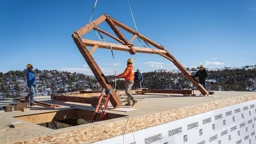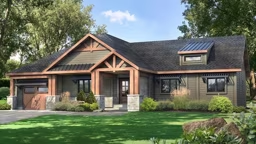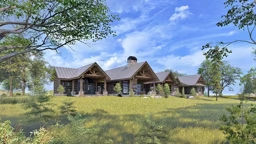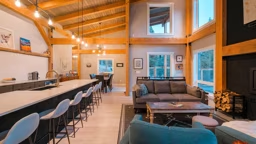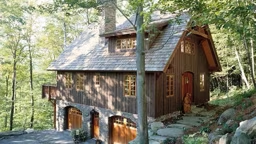This content is sponsored by Colorado Timberframe
“With a timber home, you can have any interior wall finish, any exterior wall finish, any roofing finish you want, and still have the timbers as the focal point of the home,” explains Keenan Tompkins, owner and president of Colorado Timberframe. “That means that, depending on how you design those timbers and how they’re integrated into the home, you can fit within any style you want.”
Tompkins says homeowners’ choices are influenced by factors like trends and geography. For example, what you find on the East Coast will vary greatly compared to the mountains of the West or up in the Pacific Northwest.
“On the East Coast, there’s still a big demand for what I would consider more traditional, colonial-style timber homes, which are super cool,” says Tompkins. “But the demand for that style isn’t the same in Colorado. Out here, people want mountain style, which has a totally different architectural vibe. We also have industrial, inspired by old mining structues found throughout the West, that integrate steel with wood. And then you go up in the Pacific Northwest, and they start leaning more toward modern and mountain-modern.”
With so much variety available, the choices can be overwhelming. Use this concise guide to learn more about popular styles of timber homes and decide which may be right for your dream home:
INDUSTRIAL
Where it’s popular: Tahoe, Jackson Hole, Breckenridge
Key characteristics: exposed steel brackets, bolts, and tensions rods, scissor trusses
TRADITIONAL

Photo: Courtesy Colorado Timberframe
Traditional, the most popular style, is probably what first comes to mind when you think about timber homes. Picture: steep-pitched gable roofs with pronounced, eye-catching trusses. “If you’re going for that really traditional, East-Coast timber frame style, you probably will want to stay away from exposed steel elements,” Tompkins says. Expect to find that classic, elegant look of heavy timbers connected by mortise and tenon joinery and pegs.
Where it’s popular: all along the East Coast
Key characteristics: hammerbeam trusses, king post trusses, traditional mortise and tenon joinery, corbels, dropheads
MODERN

Photo: Courtesy Colorado Timberframe
These timber frame homes incorporate modern design principles, boasting clean lines and open spaces. You'll find minimal bracing or struts and very little curvature in the design. The wood is often left its natural color for a warm, organic feel.
Where it’s popular: the Pacific Northwest, Vail, Park City
Key characteristics: flat or shed roof lines, smooth planed finish, natural wood stain or oil, sometimes the incorporation of exposed steel components
RUSTIC

Photo: Courtesy Colorado Timberframe
“This is a really cool one,” Tompkins says. He points out that what makes a timber frame appear rustic is the combination of materials, textures, and finishes. He notes that reclaimed wood is an option, but not always in-budget. Luckily, Colorado Timberframe has different methods of recreating the look of reclaimed material by distressing timbers with a wire brush or hand hewn finish. They will even go as far as giving the timbers axe marks and nail holes. "We’ve created textures that mimic what reclaimed wood looks like," Tompkins explains. "So we’re able to do a lot of really interesting things with it, and we can do custom finishes over the top so you can really make it look any way you want. That way we still have a true timber frame, and we can just go in and sprinkle elements of real reclaimed wood where you would not need the structural components.”
Additionally, different wood species can be used to achieve either a clean or rustic appearance. For example, pine typically has more knotty characteristics and, therefore, a more rustic look. Wood species with more natural checks, as you may see in oak, also create a naturally rustic appearance.
Where it’s popular: the Great Smoky Mountains, Texas, Montana, Wyoming
Key characteristics: knotty grade appearance, wire brush or hewn textured surface, reclaimed timbers
This content is sponsored by Colorado Timberframe






